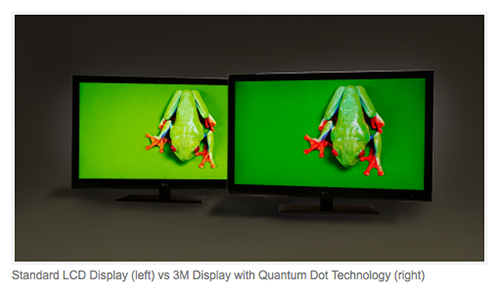Color Innovation: Quantum Dot Displays and New Standards for the AV Industry
I was on the road with an AV reseller/partner recently who asked me what companies (excluding my own) I think are the most exciting in the AV space. My answer surprised her — NanoSys and 3M (she’d never heard of NanoSys and still viewed 3M through the lens of their legacy line of projectors). So why these companies? They are at the forefront of an interesting new display technology that has the potential to improve display image quality in a dramatic way – Quantum Dots.
Haven’t heard about them? They were probably the hottest topic at last year’s SID conference, and they are already the basis for the display on the Kindle Fire HDX. Customers are increasingly demanding color accuracy for a broader range of colors on their displays. After all, if I spend $5,000 on my new 4K display for my product design collaboration center, Coca-Cola red better be just that — Coca-Cola red. The same holds true for engineering work, seismic data that could help me find the next great oil reserve…the list goes on. Quantum dots may be able to deliver a new level of color quality while reducing energy use and cost of ownership for the display itself.
So what are they? Quantum Dots are a close cousin to OLED displays, and they have steadily grown in popularity since their discovery in glass crystals in 1980 by the Russian physicist Ekimov. The discovery revealed a class of nanocrystal that is small enough to exhibit quantum mechanical properties when emitting light, which happens when it is excited by incident energy. So, just like most displays from the CRT to the OLED, when you illuminate a quantum dot with a short wavelength of energy, it will emit longer wavelength light in the visible spectrum. But what made Ekimov’s discovery interesting was that quantum mechanics dictates a very well controlled and more precise range of light emitted. This brought interest in quantum dots from researchers ranging from medical imaging to quantum computing (where the quantum dots are actually the qbits or units of quantum information).
The next several decades of materials research has positioned quantum dots as an interesting and increasingly important element in next-generation displays. By controlling the size of the particles in the quantum dot, you get more precise control over the emitted color than what is possible with current display technologies. As an example, a decent phosphor display has an emission range of about 45 nanometers, while a quantum dot can be controlled to within 2 nanometers. This type of color reproduction is astounding, and when an element is emitting energy where you want it to, less goes to wastes making it is far more efficient. Backlit displays simply cannot compare to a quantum dot matrix that can operate at over 95 percent energy efficiency.

Display advances like these — and similar innovations related to OLEDs — are exciting for the AV community. As display technologies are able to emit a larger color space with more precision, new standards are being introduced to expand the (now very old) NTSC color standard. Companies like QDVision (partnered with Sony) and NanoSys (partnered with 3M) are already bringing quantum dots to the market, and the AV industry will need to be aware of how it will impact the broader display landscape. The market research firm IHS predicts that the market for quantum dots will grow from $10 million USD in 2013 to over $200 million in 2020. So if you haven’t thought about how color quality, consistency, and energy efficiency in displays will change over the next few years, now is the time to do so…and I’d seriously consider the quantum dot as a contender.





